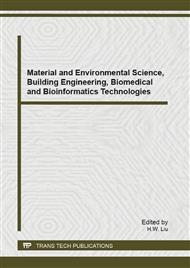[1]
K. A. Spokas: Carbon Management Vol. 1 (2010), p.289.
Google Scholar
[2]
X. Cao and W. Harris: Bioresource Technology Vol. 101 (2010), p.5222.
Google Scholar
[3]
C. Steiner, W. Teixeira, J. Lehmann, T. Nehls, J. de Macêdo, W. Blum, and W. Zech: Plant and Soil Vol. 291 (2007), p.275.
DOI: 10.1007/s11104-007-9193-9
Google Scholar
[4]
K. Y. Chan, L. Van Zwieten, I. Meszaros, A. Downie, and S. Joseph: Soil Research Vol. 45 (2007), p.629.
DOI: 10.1071/sr07109
Google Scholar
[5]
E. Marris: Nature Vol. 442 (2006), p.624.
Google Scholar
[6]
B. Glaser: Philosophical Transactions of the Royal Society B: Biological Sciences Vol. 362 (2007), p.187.
Google Scholar
[7]
K. Gell, J. van Groenigen, and M. L. Cayuela: Journal of Hazardous materials Vol. 186 (2011), p. (2017).
Google Scholar
[8]
B. Glaser, M. Parr, C. Braun, and G. Kopolo: Nature Geosci Vol. 2 (2009), p.2.
Google Scholar
[9]
X. Cao, L. Ma, Y. Liang, B. Gao, and W. Harris: Environmental Science & Technology Vol. 45 (2011), p.4884.
Google Scholar
[10]
D. L. Jones, G. Edwards-Jones, and D. V. Murphy: Soil Biology and Biochemistry Vol. 43 (2011), p.804.
Google Scholar
[11]
N. Singh and R. Kookana: Journal of Environmental Science and Health, Part B Vol. 44 (2009), p.214.
Google Scholar
[12]
Y. Mason, A. A. Ammann, A. Ulrich, and L. Sigg: Environmental Science & Technology Vol. 33 (1999), p.1588.
Google Scholar
[13]
M. Uchimiya, I. M. Lima, K. Thomas Klasson, S. Chang, L. H. Wartelle, and J. E. Rodgers: Journal of Agricultural and Food Chemistry Vol. 58 (2010), p.5538.
Google Scholar
[14]
R. S. Swift: Soil Science Vol. 166 (2001), p.858.
Google Scholar
[15]
R. S. Kookana, A. K. Sarmah, L. Van Zwieten, E. Krull, and B. Singh, Biochar Application to Soil: Agronomic and Environmental Benefits and Unintended Consequences, in Advances in Agronomy, L.S. Donald, Editor. 2011, Academic Press. p.103.
DOI: 10.1016/b978-0-12-385538-1.00003-2
Google Scholar
[16]
C. -H. Cheng, J. Lehmann, J. E. Thies, S. D. Burton, and M. H. Engelhard: Organic Geochemistry Vol. 37 (2006), p.1477.
Google Scholar
[17]
C. -H. Cheng and J. Lehmann: Chemosphere Vol. 75 (2009), p.1021.
Google Scholar
[18]
B. T. Nguyen and J. Lehmann: Organic Geochemistry Vol. 40 (2009), p.846.
Google Scholar
[19]
C. -H. Cheng, J. Lehmann, and M. H. Engelhard: Geochimica et Cosmochimica Acta Vol. 72 (2008), p.1598.
Google Scholar
[20]
B. Liang, J. Lehmann, D. Solomon, S. Sohi, J. E. Thies, J. O. Skjemstad, F. J. Luizão, M. H. Engelhard, E. G. Neves, and S. Wirick: Geochimica et Cosmochimica Acta Vol. 72 (2008), p.6069.
DOI: 10.1016/j.gca.2008.09.028
Google Scholar
[21]
S. D. Joseph, M. Camps-Arbestain, Y. Lin, P. Munroe, C. H. Chia, J. Hook, L. van Zwieten, S. Kimber, A. Cowie, B. P. Singh, J. Lehmann, N. Foidl, R. J. Smernik, and J. E. Amonette: Soil Research Vol. 48 (2010), p.501.
DOI: 10.1071/sr10009
Google Scholar
[22]
B. Nguyen, J. Lehmann, J. Kinyangi, R. Smernik, S. Riha, and M. Engelhard: Biogeochemistry Vol. 89 (2008), p.295.
DOI: 10.1007/s10533-008-9220-9
Google Scholar
[23]
B. Liang, J. Lehmann, D. Solomon, J. Kinyangi, J. Grossman, B. O'Neill, J. O. Skjemstad, J. Thies, F. J. Luizão, J. Petersen, and E. G. Neves: Soil Science Society of America Journal Vol. 70 (2006), p.1719.
DOI: 10.2136/sssaj2005.0383
Google Scholar
[24]
B. Glaser, E. Balashov, L. Haumaier, G. Guggenberger, and W. Zech: Organic Geochemistry Vol. 31 (2000), p.669.
DOI: 10.1016/s0146-6380(00)00044-9
Google Scholar
[25]
S. Brodowski, B. John, H. Flessa, and W. Amelung: European Journal of Soil Science Vol. 57 (2006), p.539.
Google Scholar
[26]
A. Keith, B. Singh, and B. P. Singh: Environmental Science & Technology Vol. 45 (2011), p.9611.
Google Scholar
[27]
U. Hamer, B. Marschner, S. Brodowski, and W. Amelung: Organic Geochemistry Vol. 35 (2004), p.823.
DOI: 10.1016/j.orggeochem.2004.03.003
Google Scholar
[28]
D. A. Wardle, M. -C. Nilsson, and O. Zackrisson: Science Vol. 320 (2008), p.629.
Google Scholar
[29]
E. D. Goldberg, Black carbon in the environment : properties and distribution / Edward D. Goldberg. Environmental Science and Technology. 1985, New York : J. Wiley.
Google Scholar
[30]
C. D. Scott, G. W. Strandberg, and S. N. Lewis: Biotechnology Progress Vol. 2 (1986), p.131.
Google Scholar
[31]
E. A. Shneour: Science Vol. 151 (1966), p.991.
Google Scholar
[32]
A. Zimmerman: Environmental Science & Technology Vol. 44 (2010), p.1295.
Google Scholar
[33]
S. E. Kolb, K. J. Fermanich, and M. E. Dornbush: Soil Science Society of America Journal Vol. 73 (2009), p.1173.
Google Scholar
[34]
K. M. Bushnaf, S. Puricelli, S. Saponaro, and D. Werner: Journal of Contaminant Hydrology Vol. 126 (2011), p.208.
DOI: 10.1016/j.jconhyd.2011.08.008
Google Scholar


